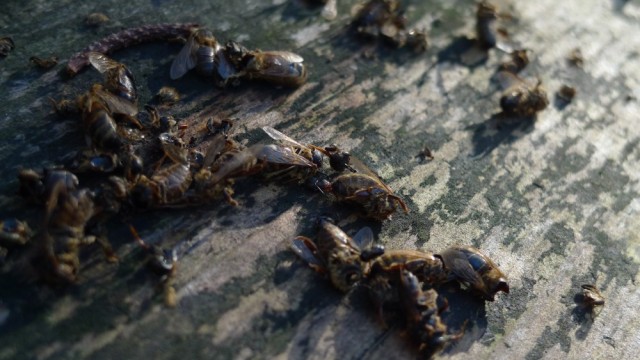Saturday was a beautiful day for doing some digging. I went down to the Ealing Dean Allotment Society’s Radbourne Walk project, behind Northfields Allotments, where they will be planting wildflowers (corn poppy, corn marigold, corn flowers, plus eventually wild foxglove, giant mullein, dark mullein, weld, lords & ladies and teasel) and putting in a stag beetle home. First the soil had to be turned over and cleared of rubbish like glass and plastic. A deep hole was dug and old logs planted in the ground for stag beetle larvae to feed on.
I was really impressed by the amount of thought that’s gone into making the Radbourne alleyway as wildlife friendly as possible and also by tea-break time, which featured flapjacks and toasted teacakes with jam. I brought along a courgette chocolate cake which people seemed to like.
Down at the apiary later, the sunshine was really lighting up the crocuses. The bees were taking their chance to fly, so much so that I put a bee suit on just in case. I’d rather be over cautious than get one caught up in my hair again.
This is a ginger cake I made. Jayne had also made some perfect crumbly rock cakes, a couple of which I got to take home with me.
Mysteriously, one of our hives had these decapitated bees on its landing board. It’s natural for the winter bees to be dying off now, but where have all their heads gone? Either they break off easily or something out there finds the heads extra tasty.
We were talking about shook swarms (a procedure to destroy old comb and shake the bees onto new foundation) and some beekeepers have done theirs already! Depending on the weather hopefully Emma and I can do this sometime this month. Then the beekeeping season will really get going.





Emily, do you have phorid flies in the UK? That may explain the headless bees (sorry for the long address, it is a .pdf online):
http://www.google.ca/url?sa=t&rct=j&q=&esrc=s&source=web&cd=1&ved=0CCkQFjAA&url=http%3A%2F%2Fhoneybhealthy.com%2FHeadlessBees.pdf&ei=71kWU7i_GsKDogT67YHoBg&usg=AFQjCNF65Um_kKaQgsMcuceyL2BC6RuWSQ&sig2=TTzkFoo5f1VWas_YjvIHHA&bvm=bv.62286460,d.cGU&cad=rja
LikeLike
Very interesting, thanks. I’m not sure if we have these flies or not, but the bees in the pdf photo look exactly like the bees on our landing board.
LikeLike
Eeewww, headless bees. We get those if we have a queen excluder under some brood frames (we might be cycling frames or the darned queen might sneak above the excluder) and then the drones die above the excluder. Their heads are too big to go through the excluder but not their body so house bees drag the bodies out of the hive and the heads just rattle around the excluder (really horrid when we open the hive and dump out a handful of heads). Could this be your problem? Do you use excluders in winter (or ever)? There shouldn’t be drones in your colony now, but hives often keep a few, just in case, and maybe their time finally came.
LikeLike
Good point – we’ve had that problem with the drones too. It’s really sad to see! We don’t have an excluder in at the moment though. I expect you get more drones overwinter than we do, although I do know a couple of beekeepers who had drones this mild winter. I haven’t seen any drones around our colonies and the bodies belonged to workers.
LikeLike
Oh the beheading… makes my skin crawl.I hope you find the culprit.
LikeLike
One of the Ealing beekeepers, Albert, joked that perhaps the queen was responsible and had been calling for beheadings of unruly subjects!
LikeLike
Oh, to see crocus! Still under snow here. Your outings often seem to involve tea cakes and such. You sure you aren’t part Hobbit?
LikeLike
Now you mention it, I am rather petite. No hairy toes yet, but perhaps those are yet to come! Wishing you a thaw and spring flowers soon.
LikeLike
Next year I’m growing crocuses. They look so vibrant! The Radbourne Walk project is such a great project. I guess it shows what can happen when people work together. I’m really impressed by the design and all the planning. It would be fun to document the different seasons with photos along the way. Ginger cake…I’d be happy to work a couple of hours to earn some cake. 🙂
LikeLike
The crocuses only open up for a couple of hours around midday, but that makes them more exciting in a way – you have to wait to see inside. The Radbourne Walk project is great, they’re drilling holes in the stag beetle logs for solitary bees too 🙂
LikeLike
Ah, then you’ll get some mason bees and leaf cutter bees too. The mason bees will finish the holes with mud and the cutter bees with leaves…at least that’s how they did at my place. I expect LOTS of pictures. 🙂
LikeLike
I’ll certainly try to catch them in action 🙂
LikeLike
Oh, I don’t expect pictures of the bees flying in and out of the holes, they are hard to catch in action. I was thinking about the mudded-in holes at the end of summer and also the overall project as progress is being made.
LikeLike
It is hard… I have some photos of a stunning solitary bee hotel here: https://adventuresinbeeland.com/2012/05/18/national-bee-unit-varroa-workshop-part-4-the-enchanted-garden/
LikeLike
Wow, that’s a real solitary bee high rise. I can only imagine how much work it was to drill all this holes. I hope he drills them straighter than mine. 🙂
LikeLike
Headless bees? Sounds nasty. In France the Asiatic hornet catches bees – frequently in front of the hive and removes the head. It then makes a nice parcel of the rest of the body and carries it off to feed its larvae. I wonder if there is another predator in the UK that attacks the bees and removes a tasty bit to take with it leaving the head and rest of the body behind? I am taking part in an initiative to try and catch some of the hornet queens as they have noticed that new nest appear often only 100-200 metres away from where nests were the previous year. My garden complies. They are going to collect some statistics too.
LikeLike
Well done for helping catch the hornet queens. I’m terrified of them managing to cross the channel, bees are struggling enough as it is.
LikeLike
Interesting, I’ve not seen any headless bees here but I did have a little look today whilst checking on our bees after reading this. Glad to hear yours are all OK at the moment. Ours started flying for the first time today once the temperature got into double figures. One colony did anyway, the other one is still snoozing!
Al.
LikeLike
Happy for you that your bees are ok. Just another couple of months to go and then I reckon we’ll be through the woods.
LikeLike
Interesting, I’ve not seen any headless bees here but I did have a little look today whilst checking on our bees after reading this. Glad to hear yours are all OK at the moment. Ours started flying for the first time today once the temperature got into double figures. One colony did anyway, the other one is still snoozing!
Al.
LikeLike
You’re making me jealous! Still well into the negatives here…I think it was -21 C yesterday night. 😦
LikeLike
Eek! I couldn’t cope with that. It seems like you guys are having an endless winter.
LikeLike
It never eeeeeeeeeeeeeeeeeennnnnnnnnnnndddddddssssssssssssssss
LikeLike
I’ve been so looking forward to the start of the 2014 cake… I mean bee season (with cake). RH
LikeLike
Ha ha! Lucky I keep bees, otherwise I wouldn’t have such a great excuse to eat cake.
LikeLike
I really like the idea of a stag beetle home, they are much maligned creatures and they look wonderful, and a bit scary, when they fly around in the summer.
LikeLike
I was interested to learn that the stag beetle larvae spend around 4-6 years underground feeding on dead wood and only a few weeks as a beetle! Their few weeks of flying must be very exciting after spending years wiggling about without any legs. Sadly many are run over whilst walking along the ground.
LikeLike
The notion of beetle habitat never crossed my mind until now. This year’s project is solitary bee nests but I may explore if any beetles here need a hand–or tarsus I guess it would be.
Love the crocus pix. Mine are still deep under the snow.
LikeLike
I think I heard somewhere that beetles are the most numerous insect in the world, which surprised me. But like the stag beetles, many are threatened from habitat destruction. It’s crazy how much snow you guys have had – we haven’t had any at all in London this winter, which is unusual.
LikeLike
I now have silly images in mind of a tiny apiarian Queen of Hearts running around the hive and shouting, “Off with their heads!” I’m glad you have crocus for your bees. Most years, my hellebores are in full bloom by now, but they’re biding their time under the latest snowfall. My crocus are just tiny green tips of leaves, so it’s lovely seeing your pictures.
LikeLike
He he, she’s out of control, beheadings are going on everywhere! Should have named her Elizabeth.
Once the tips of the crocuses are up the rest seems to follow pretty quickly. It’s exciting seeing the first flowers of the year.
LikeLike
Lovely crocuses! Still have a lot of snow here so it’s nice to see you have a lot of colors there. Have you figured out about the headless bees?
LikeLike
Half the commenters here seem to be still snowed in! You need to escape Narnia. A beekeeper on Facebook suggested wasps, which we do have around so it could be them. The head of a worker bee contains lots of glands, so I imagine those could be quite tasty.
LikeLike
You may be dealing with a different species with different predation habits, but here the wasps dismember the bodies of the honeybees, leave the legs, wings and head and fly off with the body or a gut full of bee body. Gruesome, I know. But I’d be surprised if wasps were responsible for your beheaded bees. Next time you get a crop of headless bees, pack them up and send them in for analysis. It would be interesting to see what has happened!
LikeLike
Hmm, the mystery continues. I’m not sure what kind of analysis can be done – the National Bee Unit can look for diseases or poisons present in dead bees, but can a dead body reveal what happened to its head?
LikeLike
Yes, I believe the larvae that consume the bee from inside leave a typical pattern of destruction, and traces of their presence. But as far as I know, UK should be phorid free?
LikeLike
Sounds like a very worthy project to be involved in, I haven’t seen a Stag beetle for years, so hope you get some moving in. I haven’t seen a single bee of any species or description so far this year, maybe it’s still too windy up here.
LikeLike
Thanks. Apparently a stag beetle has been spotted at the allotment, so they are hopeful that the project will be successful. Ginger is said to be a good way to attract them, as for some reason they like the smell. Has your area had flooding? There are worries that the ground dwelling bumble bees will really have suffered in the wet weather.
LikeLike